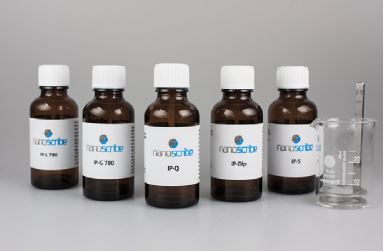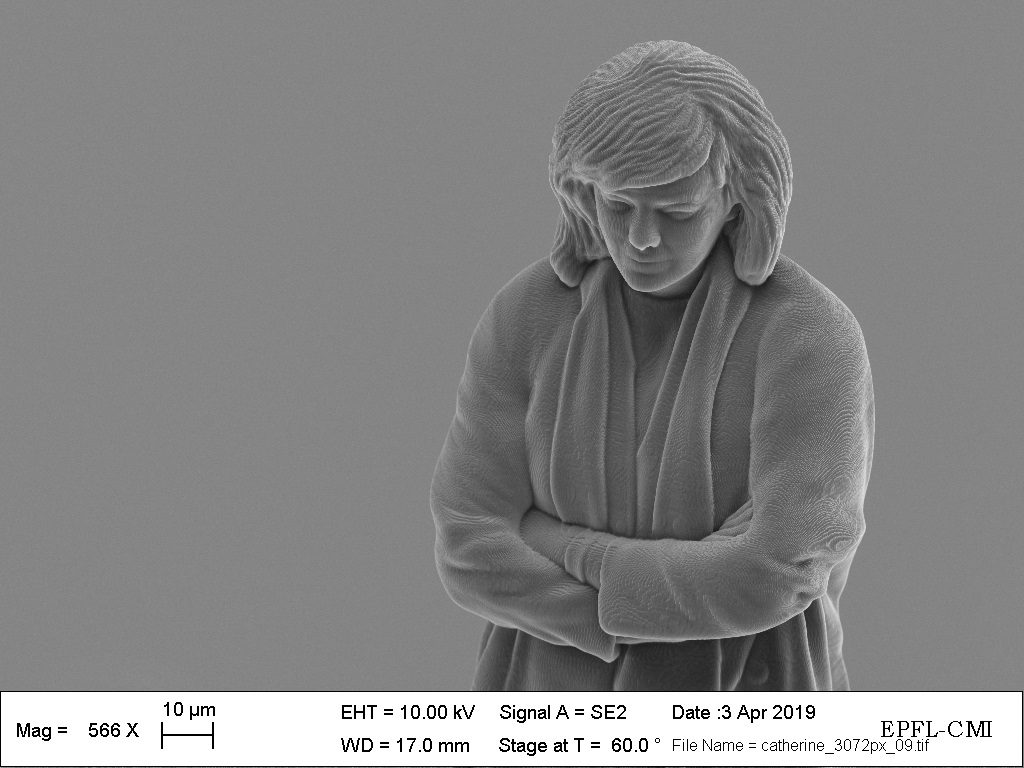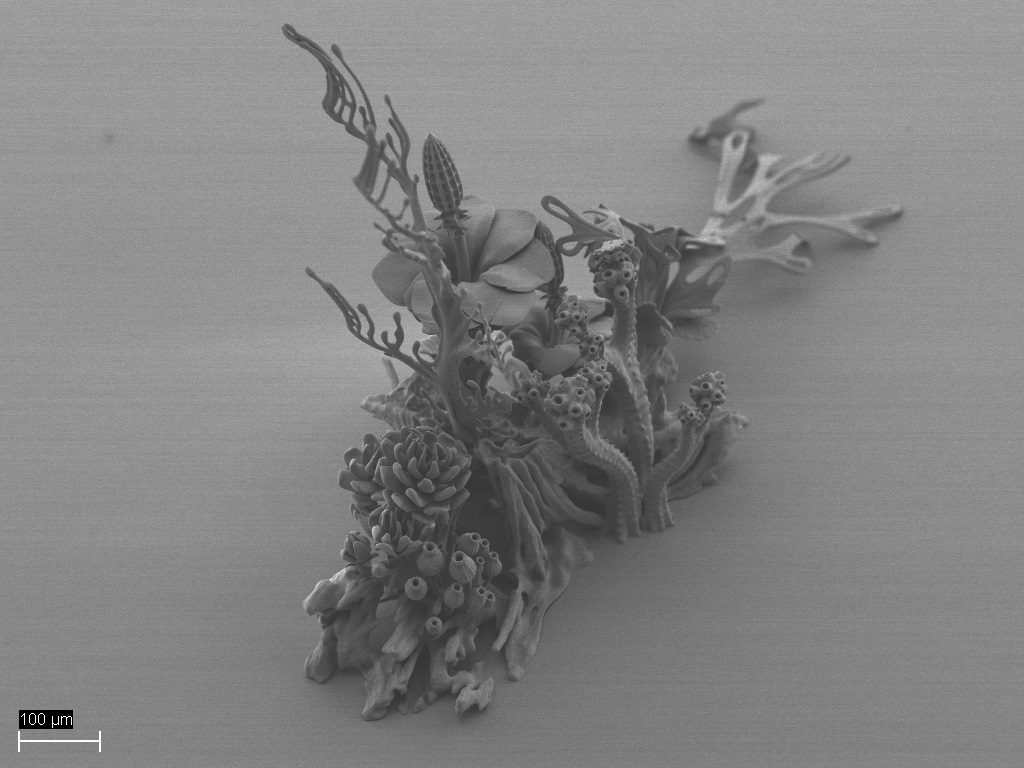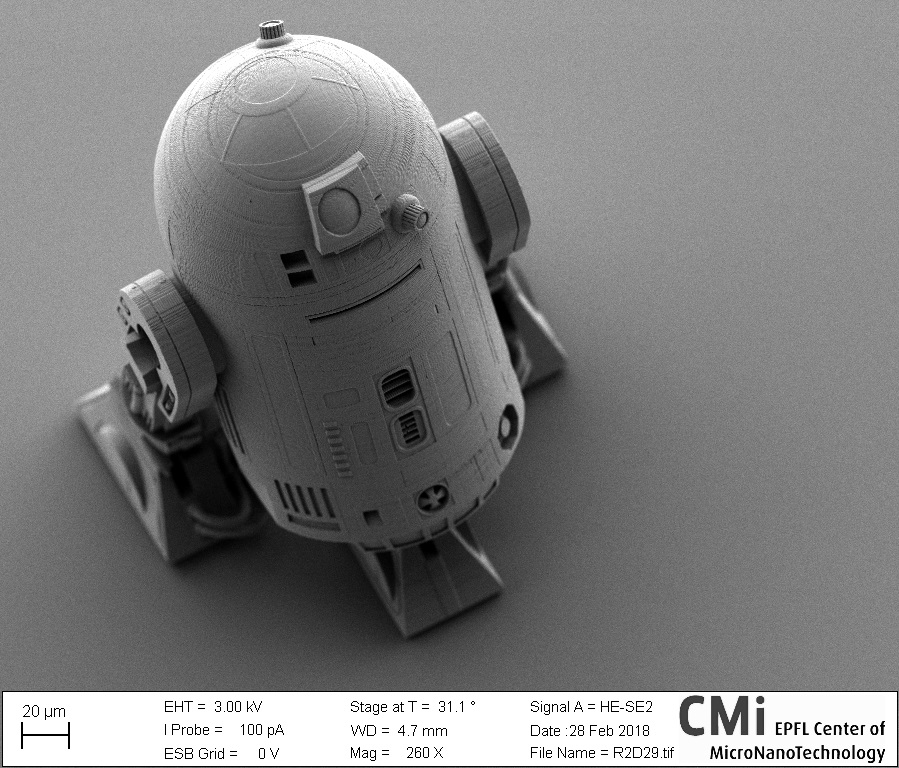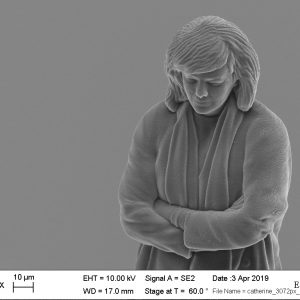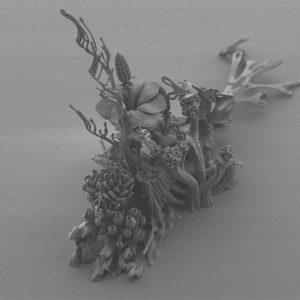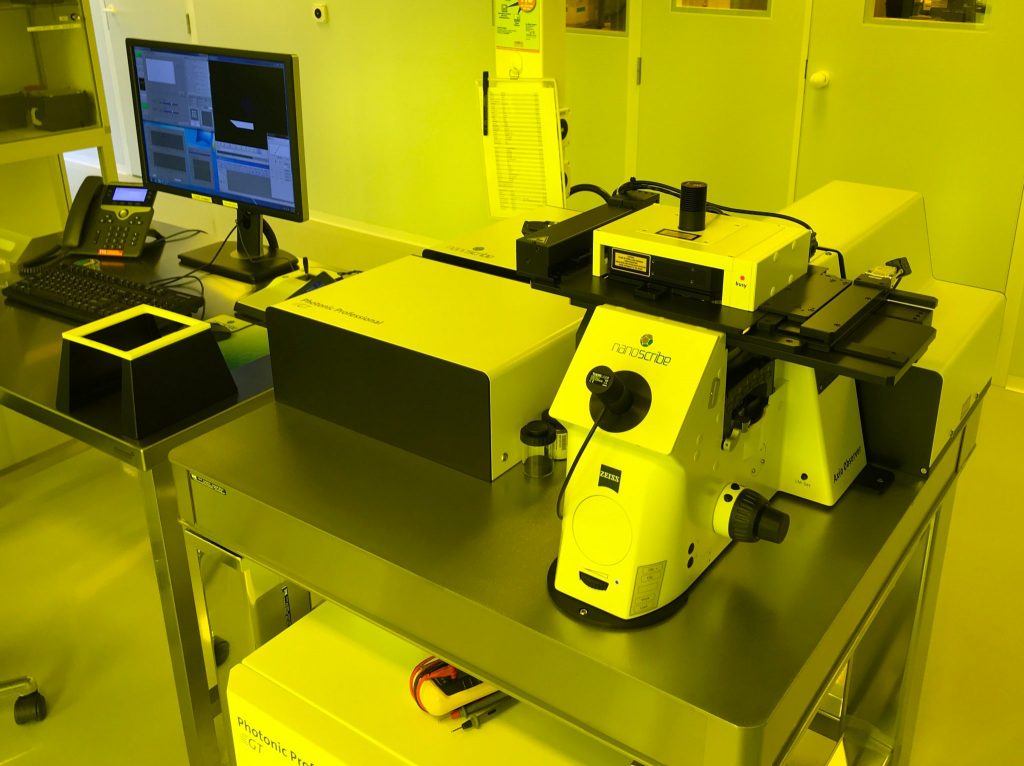
To be read first:
- The objectives used with the Nanoscribe PPGT+ equipment are extremely sensitive and expensive. Be careful during handling mounting, dismounting and cleaning steps.
- Cleaning of the objective is mandatory after each exposure session.
- Please immediately inform the CMi staff in case of problems with the objectives.
- The equipment is sensitive to vibrations. Make sure not to touch the table when exposure jobs are running.
RESERVATION RULES AND BOOKING FEES POLICY:
- No booking limit for now.
- Users with long exposure jobs (>6 hours) are encouraged to book overnight or during the weekends.
- 24/7 booking/use is possible with CMi+1 extended access.
- Reservation names must correspond to operators.
Contents:
I. Introduction
The Nanoscribe Photonic Professional GT+ is a 3-dimension (3D) nanoprinter, using two-photon absorption from an infrared (780nm) femtosecond laser to expose and polymerize UV-sensitive photoresists including standard i-line photoresists. The infrared laser is focussed through a microscope objective and the light intensity at the focal point is sufficient to pass the threshold of two-photon absorption mechanism, which means that the polymer will absorb two infrared photons simultaneously producing an energy transition in the UV to initiate the photo-polymerization reaction.
The voxel (3D pixel) is scanned inside the photoresist using three different displacement methods: a coarse stage with a precision lower than 1.5µm to move between different exposure fields, a high precision piezo-stage with a travel range of 300µm in all directions to move the wafer sample during printing (PiezoScan mode), and ultrafast galvo-mirrors to scan the laser focal point in x- and y- directions through the lens (GalvoScan mode).
Several objectives are available providing different magnifications: 20x (air), 10x (immersion), 25x (immersion), 63x (immersion) in order to optimize resolution and printing speed. To achieve the highest resolution (< 200nm lateral dimensions), the 63x objective is used with Nanoscribe IP-photoresists in dip-in laser lithography (DILL) mode, which means the lens will dip in the liquid resist to provide refractive-index matching and increase the numerical aperture of the lens.
The equipment also offer options for tilt-correction (piezo-scan mode only) and for alignment on existing wafer/sample topography.
The Nanoscribe Photonic Professional GT comes with a powerful slicing/hatching software called Describe that will convert a CAD-generated 3D structure with .STL format to the language of the equipment and generate your exposure job. Learning to use Describe is mandatory before organizing any training session on the Photonic Professional GT. Please find the manual in the manuals section below.
II. Equipment description
Objectives and resolution:
The Photonic Professional GT+ comes with four interchangeable objectives with 20x (air), 10x (immersion), 25x (immersion), 63x (immersion) magnification. The choice of the objective will have a direct effect on the voxel dimensions (resolution) and writing speed, according to the table below. Note that, due to the nature of focalisation through a lens, the voxel has an oval shape with a typical aspect ratio (z-/x- axis) of about 3.5.

Objectives |
x-/y- diameter |
z- height |
63x (immersion) |
< 200nm |
< 700nm |
25x (immersion) |
< 600nm |
< 2um |
10x (immersion) |
< 1.2um |
< 6um |
20x (air) |
< 800nm |
< 5um |
Configurations:
The Photonic Professional GT+ is a very flexible equipment which can write with several different configurations depending on the target application. Below are the three standard DILL configurations, to use with IP- resists, that the user should consider:
- High resolution mode (3D SF):
- Objective: 63x NA1.4, 360um working distance (WD).
- Standard Resist: IP-Dip2, with nIP-Dip = 1.511 @ 780nm.
- Substrate interface detection requirement: Δn > 0.04.
- Standard substrates: quartz or silicon.
- Structure maximal volume ~ 0.1 mm3.
- Micro- to mesoscale mode (3D MF):
- Objective: 25x NA0.8, 380um working distance (WD). Adjustment ring set on ‘Glyc’ !
- Standard Resist: IP-S, with nIP-S = 1.478 @ 780nm.
- Substrate interface detection requirement: Δn > 0.1.
- Standard substrates: ITO-coated glass or silicon.
- Structure maximal volume ~ 1 mm3.
- FAST macroscale mode (3D LF):
- Objective: 10x NA0.3, 700um working distance (WD).
- Standard Resist: IPX-Q, with nIP-Q = 1.48 @ 780nm.
- Substrate interface detection requirement: Δn > 0.5.
- Standard substrates: silicon.
- Structure maximal volume ~ 10 mm3.

Users may also consider the following advanced configurations that can be used with i-line photoresists other than the Nanoscribe IP- line:
- “Through glass” OIL IMMERSION mode (3D SF Oil):
- Objective: 63x NA1.4, 360um working distance (WD).
- Standard Resist: IP-L, with nIP-L = 1.477 @ 780nm.
- Substrate interface detection requirement: Δn > 0.04.
- Standard substrates: 170um-thick borosilicate, 30mm diameter.
- Immersion oil 518F: refractive index 1.518 @ 780nm.
- Structure maximal volume ~ 0.1 mm3.
- Maximum structure height is 190um due to the objective working distance limit.
- N.B. Oil immersion is also possible with the 25x objective.
- “Inverted” OIL IMMERSION mode (25-63x / spin-coated i-line resists).
- “Air” 2D and pseudo 3D mode (20x / spin-coated i-line resists).

Sample holders:
The Photonic Professionnal GT+ comes with different sample holders can be seen below. Most of them are already configured for DILL configurations. All insets in the substrates holders are designed for a specific sample thickness ! Any change in sample thicknesses should be discussed beforehand with the CMi staff.

Here is the list of standard samples that can be used with the system:
- 25 x 25 mm2 fused-silica substrate, thickness 700um (available at the system, used with the 63x DILL configuration)
- 25 x 25 mm2 ITO-coated glass substrate, thickness 700um (available at the system, used with the 25x DILL configuration)
- 25 x 25 mm2 silicon substrate, thickness 700um (available at the system, used with any DILL configurations)
- ∅ 30 mm thin borosilicate substrate, thickness 170um (available at the system, used with the 63x Oil Immersion configuration)
- microscope slides, up to 26 x 76 mm2, thickness 1mm
- 4 inch wafers, thickness between 350 and 550 um
- 2 inch wafers, thickness between 350 and 550 um
Nanoscribe IP- photoresists:
Please have a look at the Nanoscribe website for an up-to-date list of printing materials : https://www.nanoscribe.com/en/products
Some of the resist formulations are listed below:
- IP-Dip: liquid resist for the 3D SF DILL mode (63x objective).
- IP-S: liquid resist for the 3D MF DILL (25x objective). Produces smooth structures with low-shrinkage.
- IP-Q: liquid resist for the 3D LF DILL mode (10x objective). Fast 3D print of mm-size parts.
- IP-L 780: liquid resist for the OIL IMMERSION mode (63x objective).
- IP-n162: liquid resist for the 3D MF DILL mode (25x objective). High refractive index and low infrared absorption.
- IP-Visio: liquid resist for the 3D MF DILL mode (25x objective). It has very low fluorescence and is non-cytotoxic (biocompatible).
- IP-PDMS: liquid resist for the 3D MF DILL mode (25x objective). Produces soft, flexible and elastic 3D structures.
